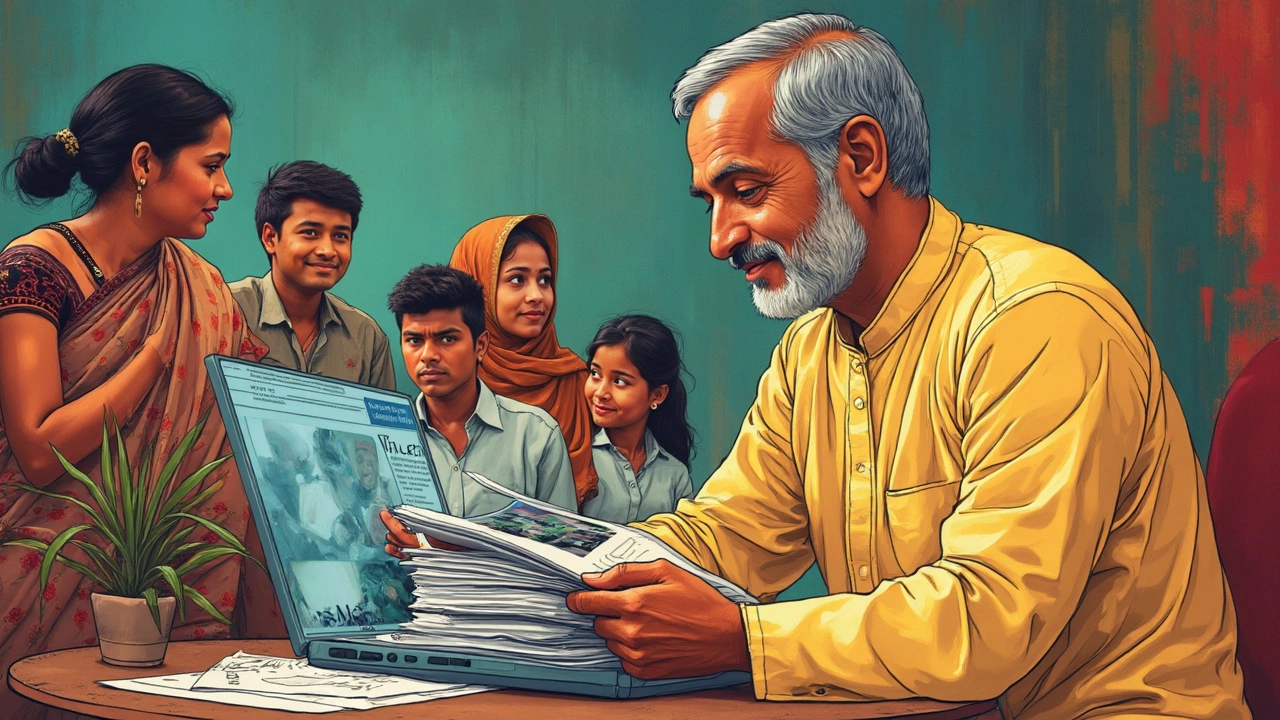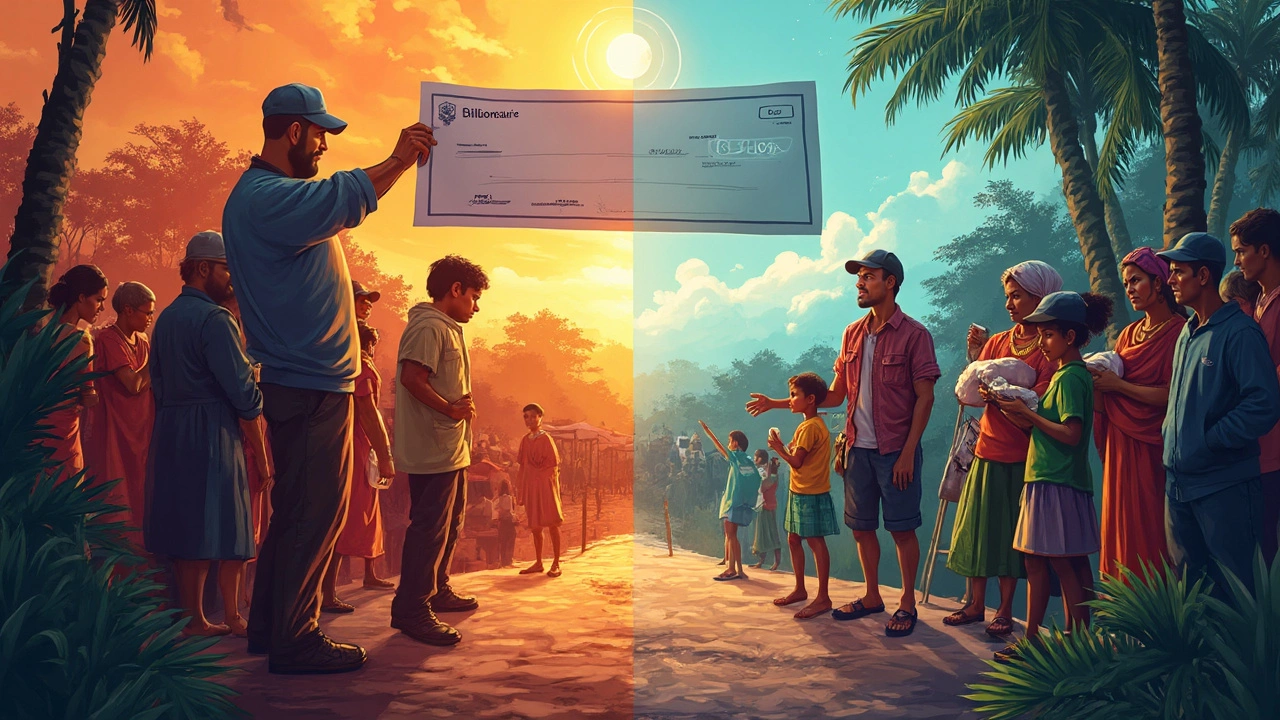Ever wondered if those billionaire headlines—‘donates billions to charity’—actually mean what they seem? You’re not alone. The truth is, not all giving is created equal, and those jaw-dropping sums need a closer look.
For starters, billionaire donations aren’t always cold-hard cash right away. Sometimes they pledge stock, park money in foundations, or set up donor-advised funds that trickle out dollars over years. Learning to spot the difference is step one if you want to figure out who’s really opening their wallet and who’s just opening doors for a fancy press release.
Of course, some names pop up again and again—think Warren Buffett, MacKenzie Scott, Bill and Melinda Gates. But the real numbers shift every year as fortunes rise and fall, and as the causes billionaires pick hit the news (remember when everyone became a pandemic philanthropist overnight?).
Knowing which billionaire tops the giving charts right now isn't just trivia—it actually tells us which causes might get big boosts, and highlights the power (and quirks) of charitable trusts. It also shows how a few people with massive bank accounts can shape whole fields, from global health to education—or, sometimes, just their own legacies.
- Not All Billionaire Giving Is Alike
- Top Givers and Their Record-Breaking Donations
- Where Does the Money Actually Go?
- Motivations Behind Massive Gifts
- How You Can Track and Judge Big Donations
Not All Billionaire Giving Is Alike
It’s easy to assume every billionaire who flashes a big donation headline is sending truckloads of cash to people in need. But if you dig a little, you’ll see the fine print matters. There are a few main ways the money moves, and some are a lot more direct than others.
Let’s start with cash gifts. When billionaires give cash to a nonprofit or a direct cause, it’s fast and usually helps right away. But that’s not the only method. Many use private foundations. These are organizations set up and controlled by the donor. Think of the Bill & Melinda Gates Foundation or the Bloomberg Philanthropies. Foundations don’t usually spend everything at once—they must legally pay out just 5% of their assets each year in the U.S. The rest can sit in investments, sometimes for decades.
Then there are donor-advised funds (DAFs). These are kind of like charitable savings accounts. Billionaires (and anyone else) put money in, get the tax break up front, and can choose when and where to send the money out—sometimes many years later. While this strategy has perks, like flexibility, the money can also just linger, helping with tax bills but not always reaching charities anytime soon.
Here’s a quick breakdown of some key donation methods and what they really mean for charities:
| Giving Method | Direct Impact on Charities | Billions Donated via This (2022) |
|---|---|---|
| Outright Cash Gifts | Immediate funds for nonprofits | $11.6 billion |
| Private Foundations | Only a portion spent each year | $45.7 billion* |
| Donor-Advised Funds | Varies, can take years to reach charities | $52.2 billion* |
*Foundation and DAF figures include assets donated, not the actual yearly spend.
One thing many people overlook is that billionaire charity donations often involve assets like company stock, which can boost headline numbers but doesn’t always mean a non-profit gets spent cash right away. For example, in 2023, Mark Zuckerberg gave Meta stock worth billions to his foundation—but the foundation can choose when to sell and spend those assets.
If you want to get a sense of real change, look at what actually makes it into the hands of the charities, not just what’s promised on paper. That’s how you separate a heart for giving from clever accounting.
Top Givers and Their Record-Breaking Donations
If you want names and numbers, here's where things get interesting. Some billionaires aren’t just sprinkling donations; they’re dropping truckloads of cash—and it’s changing what we expect from big money philanthropy.
Warren Buffett stands out every year. Since promising in 2006 to give away nearly his entire fortune, he’s given over $50 billion to various charitable foundations, mostly the Gates Foundation. He writes huge annual checks, sometimes over $4 billion a pop. He’s the heavyweight among billionaire charity donations.
Bill and Melinda Gates keep pace, too. Their foundation has pumped over $55 billion since 2000 into global health, education, and fighting poverty. Their focus on issues like malaria and education reform has gotten real results—like a major drop in childhood deaths from preventable diseases worldwide.
Then there’s MacKenzie Scott, who’s shaken up giving by writing checks fast and with little red tape. In just three years, she has donated $16 billion to over 1,900 different organizations. Her style? Surprise grants, no applications, immediate impact, and often to groups that don’t always get the spotlight, like public colleges and community food banks.
Some other big names? Mark Zuckerberg and Priscilla Chan have pledged roughly $12 billion so far through the Chan Zuckerberg Initiative, mostly to science and education. Michael Bloomberg has already put $12.7 billion toward public health, climate change, and education, and keeps updating his pledge.
| Billionaire | Total Donated (as of 2025) | Main Focus Areas |
|---|---|---|
| Warren Buffett | $50+ billion | Health, Poverty, Education |
| Bill & Melinda Gates | $55+ billion | Global Health, Education, Inequality |
| MacKenzie Scott | $16 billion | Equity, Access, Local Groups |
| Michael Bloomberg | $12.7 billion | Public Health, Climate, Arts |
| Mark Zuckerberg & Priscilla Chan | $12 billion | Science, Education, Justice Reform |
If you like stats, here’s a tip: tracking totals alone isn’t the full story. Some donors lock their money in foundations, which spread out the cash slowly, while others (like Scott) give now and ask questions later. So, if you hear that a billionaire topped the giving list, check if the dollars are actually out the door or just sitting on the runway, waiting for takeoff.

Where Does the Money Actually Go?
Billionaire donations sound huge, but tracing every dollar isn’t as simple as checking a bank transfer. When MacKenzie Scott made headlines for her no-strings-attached gifts, actual checks landed directly at small nonprofits—groups like Goodwill, Meals on Wheels, and local YMCAs reported surprise windfalls. But that’s not the norm for every big name.
Most of the time, when you hear about big billionaires making a donation, the money is moving into a private foundation or a donor-advised fund. Foundations like the Bill & Melinda Gates Foundation, for example, oversee programs in global health, vaccines, and education. That money gets handed out through grants, which go to research, hands-on projects, and sometimes to other charities. But it almost never means someone writes a single check for a billion dollars and waves goodbye to it.
| Billionaire | Foundation or Charity | Top Supported Causes | Yearly Grants (2023) |
|---|---|---|---|
| Bill & Melinda Gates | Gates Foundation | Global health, education, poverty | $7.5 billion |
| MacKenzie Scott | Direct to nonprofits | Racial equity, education, social justice | $2.1 billion |
| Warren Buffett | Gates and other family foundations | Public health, poverty, education | $4.5 billion |
Why does this matter? Because if a billionaire gives to their own trust, the cash isn’t always required to go out right away. For example, US foundations must give just 5% yearly, so money can sit and grow for decades. Meanwhile, organizations waiting for help sometimes have to be patient—or get creative.
If you want to see where billionaire donations end up, check public filings. US-based foundations file something called a Form 990, which breaks down every grant. Places like Charity Navigator or Guidestar let anyone peek inside. Bottom line: direct giving to nonprofits is fastest, while foundation or fund donations take longer to hit the ground. If you really want your money to do work now, that difference matters.
- Look up a foundation’s grants by searching their yearly reports.
- Check for details on which programs or projects got top dollars.
- Use tools like Charity Navigator to spot direct gifts versus money locked in a trust.
The billionaire charity donations headline is only part of the story—the real impact depends on how, where, and when the money actually shows up.
Motivations Behind Massive Gifts
It’s easy to assume that billionaires give just because they care. Sure, some are honestly moved by the issues they support. But there’s always more to the story, and understanding why they give changes how you read those headline numbers about the most generous billionaires.
Some billionaires are truly passionate—take MacKenzie Scott, who chooses groups focused on equity and rarely attaches conditions to her donations. Warren Buffett, the king of value investing, talks straight up about not needing all his money while alive and wanting it to do more good in the world than sitting in his bank account. Others, though, join public giving pledges like The Giving Pledge, which is partly about legacy and setting an example for other mega-rich folks.
For others, tax benefits are tough to ignore. In the U.S., donating to a registered charity can cut your tax bill, sometimes by millions. Think about it: giving $1 billion away might mean saving hundreds of millions in taxes, so it's both a good deed and good business sense. Then there's reputation. Billionaires know their public image matters, especially when they’re in the headlines for the wrong reasons. A high-profile donation can flip the narrative, fast.
Some want control—by setting up their own charitable trusts or foundations, they get to choose exactly where the money goes and when. It's also a way of keeping influence long after they’re gone. Foundations like the Bill & Melinda Gates Foundation have become as well-known as the people who started them.
Here’s a quick rundown of real reasons billionaires often give big:
- Genuine belief in a cause or desire to fix a problem
- Tax advantages that come with huge donations
- Boosting personal or family reputation and leaving a legacy
- Controlling how, when, and where money is used
- Responding to pressure—peer influence from other big donors or even bad press
Want some real world stats? Here's what motivates the top givers, based on interviews and public statements:
| Billionaire | Main Giving Motivation |
|---|---|
| MacKenzie Scott | Addressing equity and social justice; no-strings giving |
| Warren Buffett | Not needing wealth; giving back to society |
| Bill & Melinda Gates | Solving global health and education challenges |
| Elon Musk | Leaving a mark; education and climate concerns but skeptical of big foundations |
| Mark Zuckerberg | Long-term change through personalized philanthropy |
So when you see a billionaire in the news for their latest mega-gift, remember: the real motivation might be a mix of heart, money, reputation, and maybe a little old-fashioned competition too.

How You Can Track and Judge Big Donations
If you want to know which top philanthropists are actually giving away loads of money—and not just writing social media posts about it—there are some real ways to check. Don’t just trust the headlines. Get a little nosy! Here’s how you can separate the big talk from the real action.
Start with tools and websites that track giving. A couple of honest favorites:
- Forbes' Top Givers Lists: Updated regularly, shows who’s really giving the most (check their methodology for details).
- The Life You Can Save: Ranks charities by impact, plus they comment on big donations and where they go.
- Charity Navigator: You can look up ratings for charitable organizations and sometimes spot if billionaire gifts actually land in effective places.
If you want to double-check if a billionaire is really paying out what they claim, peek at their foundation’s IRS Form 990. It sounds scary, but it’s public and can often be found on sites like GuideStar. Look for the “Grants Paid” sections over a few years. Are the numbers close to the huge figure they announced, or much smaller?
Another biggie: notice if their donation was a pledge or an actual transfer. For example, in 2010, Warren Buffett pledged to give away about 99% of his wealth but started by donating stock annually to the Gates Foundation and other family foundations, so his gifts show up in chunks over time.
If you ever see headlines like “$10 billion pledged,” check if any of it is going directly to causes or if it lands mostly in a new foundation (sometimes that means tax perks first, impact later).
Below is a summary of what a few headline billionaire donations looked like in the years they were announced vs. what actually made it out the door during that period:
| Billionaire | Year Pledged | Announced Amount (USD) | Actual Paid Out Within 2 Years |
|---|---|---|---|
| MacKenzie Scott | 2020 | $5.8 billion | $5.8 billion (directly to charities, no foundation) |
| Bill & Melinda Gates | 2021 | $15 billion (added to foundation) | About $6.7 billion paid out in grants in two years |
| Warren Buffett | 2023 | $4.6 billion (stock donation) | $4.6 billion moved to foundations, payouts staggered |
| Jeff Bezos | 2022 | $10 billion pledge (Bezos Earth Fund) | About $2.4 billion granted in first 2 years |
Real talk? Dig beyond the news. If a billionaire claims a huge gift, check if it’s actually helping real organizations right now. Most public foundations post annual reports you can skim. Find out if their grants support direct impact (shelters, vaccines, student help) or if it stays in “endowment” mode for years on end.
If you’re comparing how generous someone is, look up their net worth. A $1 billion gift is huge, but for someone worth $100 billion, it’s only 1%. Percentage of wealth matters just as much as raw dollars—sometimes more.
For folks curious about who walks the walk, try these steps:
- Search for recent independent lists or annual reports like Forbes or Chronicle of Philanthropy.
- Check for foundation 990 filings—they show real money out the door.
- Look for updates or follow-up stories, not just the big “pledge” headline.
- Consider impact: Where’s the money going? Big social change or comfy PR win?
Bottom line—don’t just trust the hype. With a little poking around, you can spot the most generous billionaires and know a massive difference is actually being made—rather than just talked about at fancy galas.
